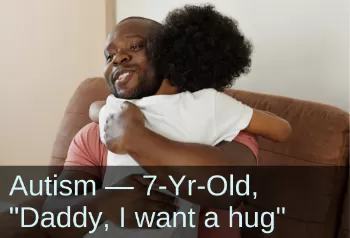Primitive Reflex Integration Case Studies
Autism—Huge Improvements in Speech, Sensory, Eye Contact, and Attention
Primitive reflex integration helps a 7-year-old with autism connect with those around him.
Tools from the Brain and Sensory Foundations program help a little boy with autism to move beyond emotional dysregulation as well as sensory processing, speech, and impulse control issues.
Submitted by Heather Bowsher, COTA

| Before | After |
|---|---|
| Very little speech | More verbal |
| Did not seek connection with those around him | For the first time, spoke to his father with a specific request (a hug!); also started playing with his sister |
| Did not make eye contact | Started to make brief eye contact |
| Difficulty with sensory aversion | Used kinetic sand and other sensory play tasks with no aversion |
| Could participate in therapist tasks for only brief amounts of time | Increased attention span |
Patient B is a 7-year-old boy with Autism who had difficulty with speech, impulse control, sensory aversion, very little speech and was routinely dysregulated. His father repeatedly said "I just want my boy to talk to me." He frequently did not attend to therapist directives and wanted to participate in high energy activities that gave him the maximum amount of vestibular input available such as swinging on a trapeze bar upside down, jumping into the ball pit, or climbing the rock wall or monkey bars repetitively. He would only participate in therapist tasks for brief amounts of time; initially only up to 30 seconds.
Upon our 4th session together I began using the rhythmic movements and activities [from the Brain and Sensory Foundations course] with him along with a brushing protocol. After the third session I noticed that he would allow brief eye contact with me which he had not done before or with any other therapist. When he and both parents arrived for our fourth session his parents came to me with tears and said he had been saying my name at home asking for me. By completion of our 6th session his father came back to me saying that his son purposely came to him and looked at him and said "Daddy, I want hug." His father stated this was the first time the boy actively sought him out and spoke to him in a direct manner with a specific request. He also stated that the little boy had increased attention span, played with his sister using kinetic sand and other sensory play tasks with no aversion.
[Edited for length and clarity; emphasis added]
*Disclaimer: The activities in the Brain and Sensory Foundations curriculum make use of the natural processes of neuroplasticity and development that are innately wired in the design of human beings to promote maturity and function. These activities appear to calm, organize, and mature the neuro-sensory-motor systems just as we see in the healthy development of human infants. Individual results may vary, and we do not claim to offer a diagnosis or cure for any specific condition or disorder. The Brain and Sensory Foundations activities appear to improve overall functioning resulting in measurable improvements for a range of conditions as demonstrated in over 1800 case studies from participants.

